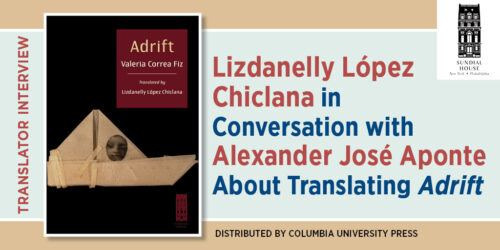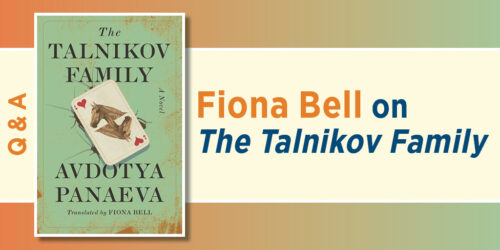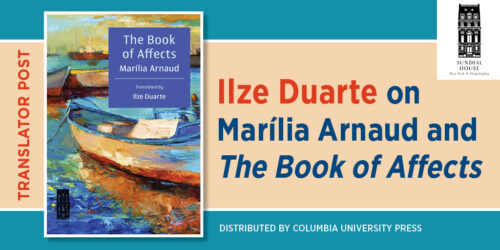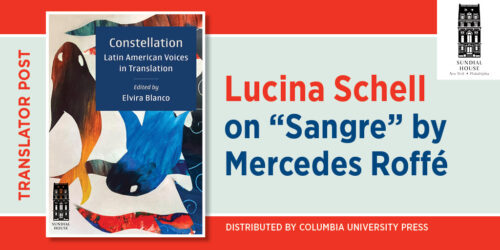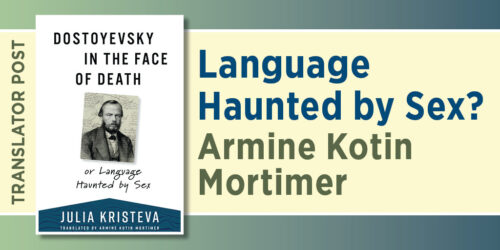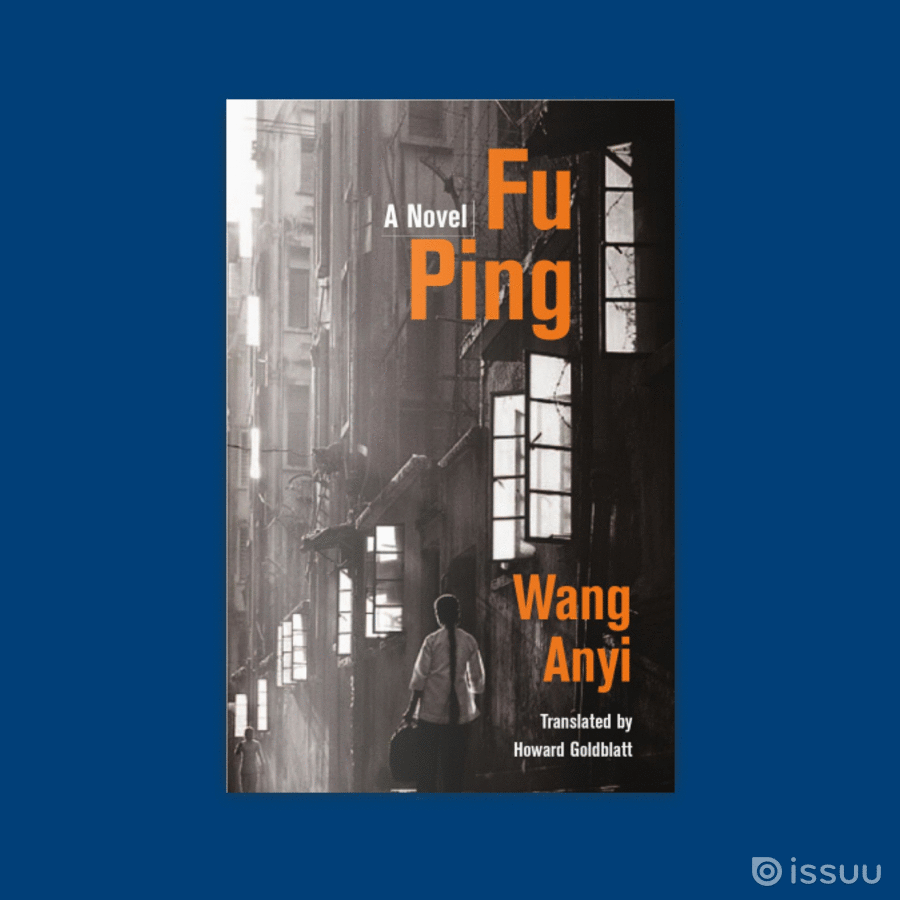Christina MacSweeney on The Company

If asked, I describe myself as a literary translator. But what exactly does the adjective “literary” mean? How is what I do different from what, for example, a legal translator does? The simplistic response is that legal translation has a specific lexicon and aims for clarity: metaphor is not something I would expect to find in a legal document. And whereas I can have a fairly clear notion of what a legal text is like, just what can or can’t be considered a literary text? What distinguishes many of the texts I translate is their ability to defy genre classification. In fact, they problematize the very concept of literature, and in doing so offer a fuller reading experience.
Verónica Gerber Bicecci describes herself as a “visual artist who writes.” So is what she does literature or art? I feel there is a false dichotomy in that question. In my understanding, her work is an exercise of creativity, abolishing the hierarchy in which the word tends to have a higher value than the image. In her visual essay “Las palabras y las imágenes” (“Words and Images,” in Visible: Text + Image [Two Lines Press, 2022]), a rewriting of René Magritte’s “Les mots et les images,” Gerber Bicecci contends that “the image-text relationship is inescapable. In fact, there is no difference between them, only a problem known as logocentrism.” And “we don’t live in the age of the image: We live in the calligramatic age.” The word does not have primacy in her work; the word alone cannot contain the world that contains it.
It has been a great pleasure for me to collaborate with Verónica Gerber Bicecci on a variety of translation projects. Our first was her graphic novel Empty Set (Coffee House Press, 2018), but we have also worked on poetry and the bilingual text Palabras Migrantes / Migrant Words (Impronta, 2018). Verónica is among those authors who consider translation to be writing, and while she is keen to be involved, she is always respectful of my task and skills. Not all authors can or wish to collaborate in this way, but in my experience, when this is possible the dialogue between author and translator leads to a deeper understanding of the work.
In her book The Company, Gerber Bicecci questions not only this word-image hierarchy but also the notion of originality in a rewriting of Amparo Dávila’s classic short story “El huésped” (“The Houseguest”). In section a., she writes the text word for word, making only minor alterations, such as transposing the verb tense to the future. The text is interspersed with images, including high-contrast photographs taken by Gerber Bicecci during a journey to the area around the former Mexican mercury-mining town of Nuevo Mercurio and fragments from Manuel Felguérez’s (1975) pictograms for La máquina estética (The Aesthetic Machine). In section b. she employs a wide variety of sources to build up a socio-anthropological picture of the devastation caused by mining that, in her epilogue, Cristina Rivera Garza categorizes as “an exemplary disappropriative work.”
A translator can’t necessarily rely on the images to provide immediate support; the revelation may appear in some other part of the book.
What is the task of the translator in this environment? One of the areas that I feel is key is an awareness of text as a whole. Unlike in an illustrated book, in Gerber Bicecci’s work the visual material may or may not refer directly to the surrounding text. A translator can’t necessarily rely on the images to provide immediate support; the revelation may appear in some other part of the book. So I feel I must keep the bigger picture in mind at all times.
In section a. my first decision was whether to seek permission of the original translators of the short story (Audrey Harris and Matthew Gleeson) to rewrite. After giving the issue some thought, I decided that my best strategy would be to retranslate the short story in its new environment, imagining it in Nuevo Mercurio with the oppressive presence of the mine embodied in The Company, and when a pronoun was required, I decided to dehumanize that presence by the use of “It.” The final decision I took, in collaboration with Verónica, was to use future tense with “will” as opposed to “going to,” as it suggests a prediction that is true. This, I feel, heightens the ominously oppressive aspects of the story.
While the voice in a. is that of an omniscient narrator, b. employs a multiplicity of voices and registers. The most endearing must be that of Long Tall José, a farmworker who, one day, when out searching for honey, comes across some strange rocks that are later showed to contain cinnabar, from which mercury can be extracted. Almost overnight Long Tall José finds himself with a 10 percent share in a mercury mine. The reference to mercury and cinnabar brings me back to my original question about literary translations, because here, I have to take on the roles of both literary and nonliterary translator within a single creative work. A particular challenge in this section was the terminology; my knowledge of the specifics of coal mining was limited, and in relation to mercury, almost nonexistent. Glossaries, of course, were very useful, as were the diagrams in the book showing cross-sections of the mines. But even so, I often found myself close to tearing my hair out.
It is up to us as readers—as viewers—to decide how far we are willing to engage with it.
This version of The Company is enhanced by Cristina Rivera Garza’s epilogue, which is an extended version of the text that accompanied Gerber Bicecci’s exhibition Barefoot feet, the fields in them. I will feel the creditor of the land on my bare soles. Rivera Garza adds a new voice to the chorus as she theorizes notions of appropriation and disappropriation. Here, she points out that rather than “appropriating” the narrative of Nuevo Mercurio, Gerber Bicecci simply displays it. What we see is “the product of research and selection of material from the world we share” rather than some form of divine inspiration. It is up to us as readers—as viewers—to decide how far we are willing to engage with it.
In discussing the process through which a mural/book in an exhibition space becomes a physical book on a shelf, it is easy to forget that there is a publishing house and editing team involved. It was no simple task to find a home for such a unique product as The Company, so Verónica and I were absolutely delighted to be awarded the 2024 Sundial House Translation Award that has made this publication possible. Sundial House has our eternal thanks. I would also like to extend those thanks to the editing team who have dealt with the demands of such a book with patience and understanding: Eunice Rodríguez Ferguson and Lisa Hamm from Sundial House, plus Alexia Halteman from Impronta Casa Editora, Guadalajara.
The Company truly is a choral work.
Christina MacSweeney is the translator of The Company by Verónica Gerber Bicecci.


